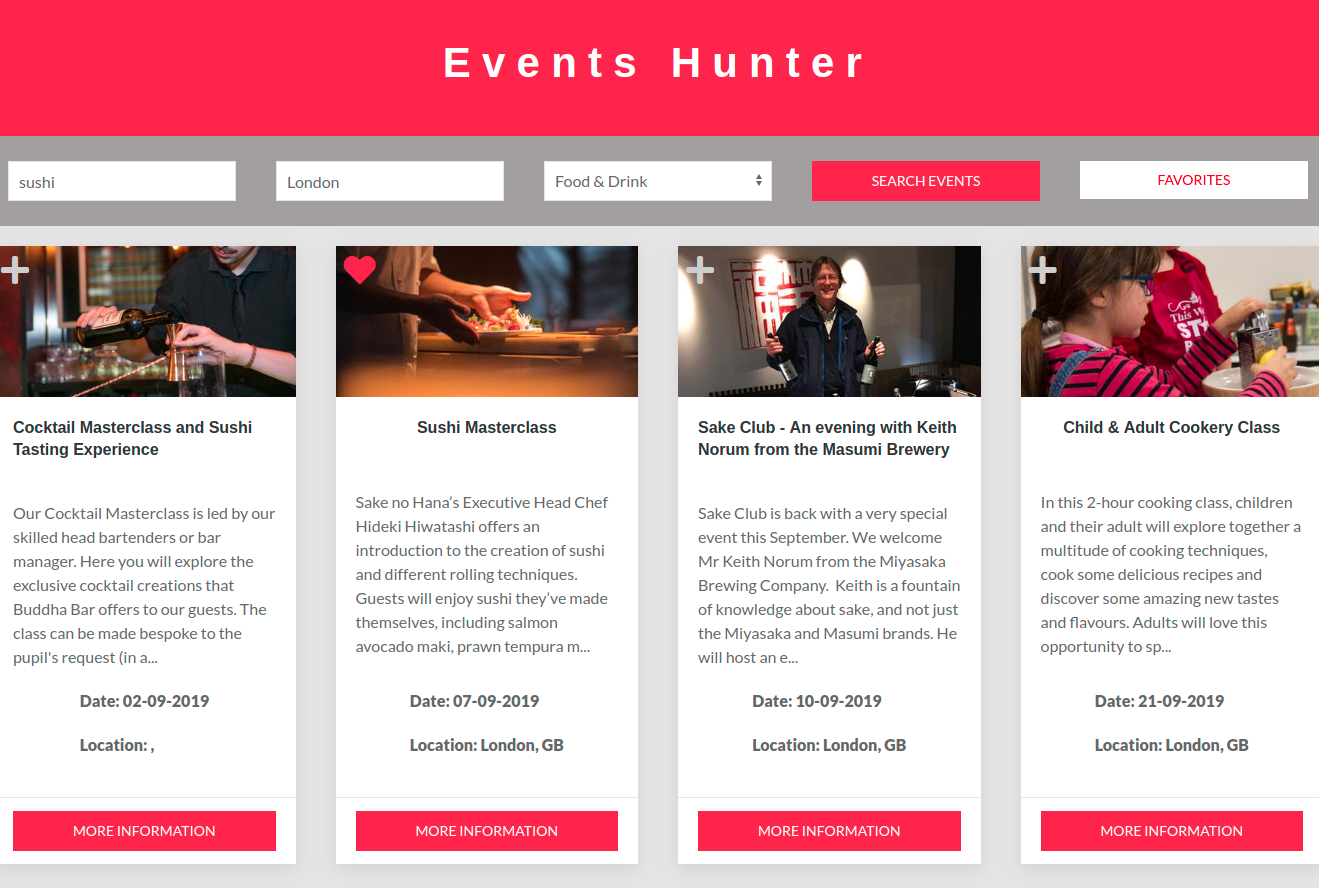EVENTS HUNTER
In this page you can obtain information about events of several categories and places. You can save in favourites all the events you have liked the most. Project developed with React, layout applied with UIkit and data obtained from Eventbrite API.
Features
- The web allows to search events information with three optional criteria: the event name, the city, and the category which belongs.
- The searcher finds matches in an external API (Eventbrite API).
- The results are shown in an organized grid layout.
- In every card event has been included a 'More information' button to click in to open a new website with all the information about it.
- There is an icon in the left top of every event to mark it as favorite.
- The events are sincronized with the saved favorites when a new search is done showing a red heart.
- Favorites kept saved even when the webpage is closed or reloaded.
What I learned
- Obtain data from Eventbrite API and how to extend the default information.
- Generate layout with UIkit classes.
- Make queries to the API with NPM Axios through async functions.
- Build a favourites section and syncronize them with new searches.
- Save favourites data with LocalStorage.
Resources
- Icons from Font Awesome.
- For the data events I utilized an external API: Eventbrite API.
- Layout and styles with UIkit
- To make queries to the API with Axios, a package from NPM.
- This project was bootstrapped with Create React App, from Facebook.
Usage
To run the game in local:
- Install Node.js at the terminal if you haven't yet (https://nodejs.org/es/). Commands for Ubuntu:
sudo apt-get update
sudo apt-get install nodejs- You will need to install the package manager npm:
sudo apt-get install npm- Clone or download the repository in your computer.
git clone https://github.com/diana-moreno/events-searcher-React-API.git`- Download the npm competitions in your own repository and start it.
npm install
npm start- Otherwise, you can run the final project here: https://diana-moreno.github.io/events-searcher-React-API/
Available Scripts
In the project directory, you can run:
npm start
Runs the app in the development mode.
Open http://localhost:3000 to view it in the browser.
The page will reload if you make edits.
You will also see any lint errors in the console.
npm test
Launches the test runner in the interactive watch mode.
See the section about running tests for more information.
npm run build
Builds the app for production to the build folder.
It correctly bundles React in production mode and optimizes the build for the best performance.
The build is minified and the filenames include the hashes.
Your app is ready to be deployed!
See the section about deployment for more information.
npm run eject
Note: this is a one-way operation. Once you eject, you can’t go back!
If you aren’t satisfied with the build tool and configuration choices, you can eject at any time. This command will remove the single build dependency from your project.
Instead, it will copy all the configuration files and the transitive dependencies (Webpack, Babel, ESLint, etc) right into your project so you have full control over them. All of the commands except eject will still work, but they will point to the copied scripts so you can tweak them. At this point you’re on your own.
You don’t have to ever use eject. The curated feature set is suitable for small and middle deployments, and you shouldn’t feel obligated to use this feature. However we understand that this tool wouldn’t be useful if you couldn’t customize it when you are ready for it.
More
Learn More
You can learn more in the Create React App documentation.
To learn React, check out the React documentation.
Code Splitting
This section has moved here: https://facebook.github.io/create-react-app/docs/code-splitting
Analyzing the Bundle Size
This section has moved here: https://facebook.github.io/create-react-app/docs/analyzing-the-bundle-size
Making a Progressive Web App
This section has moved here: https://facebook.github.io/create-react-app/docs/making-a-progressive-web-app
Advanced Configuration
This section has moved here: https://facebook.github.io/create-react-app/docs/advanced-configuration
Deployment
This section has moved here: https://facebook.github.io/create-react-app/docs/deployment
npm run build fails to minify
This section has moved here: https://facebook.github.io/create-react-app/docs/troubleshooting#npm-run-build-fails-to-minify
